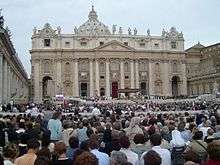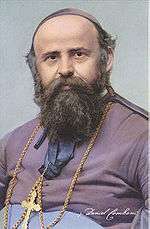Saint Daniele Comboni
| Saint Daniel Comboni | |
|---|---|
|
Portrait of St. Daniel Comboni | |
| Born |
15 March 1831 Limone sul Garda, Italy |
| Died |
10 October 1881 (aged 50) Khartoum, Sudan, Africa |
| Venerated in | Roman Catholic Church |
| Beatified | 17 March 1996, Rome by John Paul II |
| Canonized | 5 October 2003, Rome by John Paul II |
| Feast | 10 October |
Daniel Comboni (15 March 1831 – 10 October 1881) was a Roman Catholic missionary to Africa who was canonized as a saint.[1]
Early life
Comboni was born on 15 March 1831 in at Limone sul Garda, Brescia, Italy,[2] to parents Luigi and Domenica Comboni, a poor family of cultivators employed by a local proprietor. Daniel was the only one of eight children to survive into adulthood. Daniel was sent away to school in Verona, at the institute founded by Father Nicola Mazza. There he completed his studies and prepared to become a priest.[2] He heard descriptions at Fr. Mazza's Institute by the missionaries who returned from Central Africa. On 31 December 1854, the year of the proclamation of the Immaculate Conception of Mary, Daniel was ordained a priest by the bishop of Trent, Blessed John Tschiderer. Three years later, with the blessing of his mother, he left for Africa along with five other missionaries of the Mazza Institute.
Mission to Africa
After four months Comboni reached Khartoum, capital of the Sudan. There were many difficulties, including unbearable climate, sickness, the deaths of several of his young fellow-missionaries, and the poverty and dereliction of the population. From the mission of Holy Cross he wrote to his parents: "We will have to labour hard, to sweat, to die: but the thought that one sweats and dies for love of Jesus Christ and the salvation of the most abandoned souls in the world, is far too sweet for us to desist from this great enterprise".
After witnessing the death of one of his missionary companions, Daniel remained determined to continue, and wrote: "O Nigrizia[3] o morte!"—"Either Africa, or death".
Comboni worked out a fresh missionary strategy in 1864 in Italy. While praying at the Tomb of Saint Peter in Rome, Daniel came upon the idea of a "Plan for the Rebirth of Africa", a missionary project with the slogan "Save Africa through Africa".
Missionary bishop

Comboni wanted European society and the Church to be more concerned with Central Africa. He carried out missionary appeals throughout Europe for spiritual and material aid for the African missions from people including royalty, bishops and nobles. Around this time he launched a missionary magazine, the first in Italy.
Comboni established a men's missionary institute in 1867 and one for women in 1872: the "Comboni Missionaries" (Latin: Missionarii Comboniani Cordis Jesu, whence their abbreviation MCCJ) and the "Comboni Missionary Sisters", or the "Verona Fathers and Sisters". Comboni was the first to bring women into missionary work in Central Africa.
Comboni took part in the First Vatican Council as the theologian of the Bishop of Verona, and formulated the Postulatum pro Nigris Africæ Centralis, a petition for the evangelisation of Central Africa, which was signed by 70 bishops. The Council was terminated by the outbreak of the Franco-Prussian war before the Postulatum could be discussed.
On 2 July 1877 Comboni was named Vicar Apostolic of Central Africa, and ordained bishop in August 1877. Comboni's Vatican biography says that this was seen as a confirmation that his ideas and his activities, which were considered by some to be foolhardy, were recognised as a truly effective means for the proclamation of the Gospel.[1]
In 1877 and 1878 there was a drought in the region of the mission followed by mass starvation that was considered without precedent. The local population was halved, and the missionary personnel and their activities reduced almost to nothing.
Final African Mission
In 1880 Bishop Comboni traveled to the mission in Africa for the eighth and final time, to act against the slave trade. On 10 October 1881, after falling gravely ill from disease, he died in Khartoum. His final words were reported to be: "I am dying, but my work will not die".
Comboni Missionaries
The Verona Fathers later changed their name to the Comboni Missionaries. The Comboni Missionaries comprised 328 houses with 1,803 members, of whom 1,296 are priests, spread all over the world.[4]
References
- 1 2 "Daniel Comboni (1831-1881)", Vatican biography
- 1 2 Lenhart, John. "Daniel Comboni." The Catholic Encyclopedia. Vol. 4. New York: Robert Appleton Company, 1908. 8 Mar. 2014
- ↑ "Chi siamo - nigrizia.it". Nigrizia.it (in Italian). Retrieved 11 August 2016. "Nigrizia" comes from the Laitin "nigritia" (blackness), and in Italian referred in the 19th century to sub-Saharan Africa, the country of the black people.
- ↑ Ann. Pont. 2010, p. 1451.
Sources
| Wikisource has the text of the 1913 Catholic Encyclopedia article Daniel Comboni. |
Coordinates: 45°26′46″N 11°0′21″E / 45.44611°N 11.00583°E
Facebook address: https://www.facebook.com/ComboniSistersUSA
